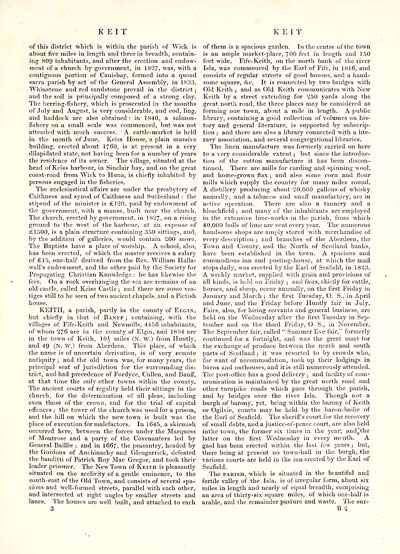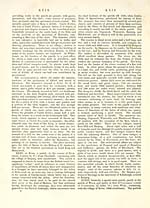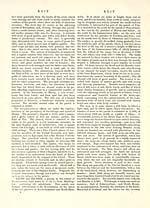Topographical dictionary of Scotland > Volume 2
(11) Page 3
Download files
Complete book:
Individual page:
Thumbnail gallery: Grid view | List view

K E IT
KEIT
of this district which is within the parish of Wick is
about five miles in length and three in breadth, contain-
ing S09 inhabitants, and after the erection and endow-
ment of a church by government, in 1S27, was, with a
contiguous portion of Canisbay, formed into a quoad
sacra parish by act of the General Assembly, in 1S33.
Whin-Stone and red sandstone prevail in the district ;
and the soil is principally composed of a strong clay.
The herring-fishery, which is prosecuted in the months
of July and August, is very considerable, and cod, ling,
and haddock are also obtained : in 1840, a salmon-
fishery on a small scale was commenced, but was not
attended with much success. A cattle-market is held
in the month of June. Keiss House, a plain massive
building, erected about 1760, is at present in a very
dilapidated state, not having been for a number of years
the residence of its owner. The village, situated at the
head of Kciss harbour, in Sinclair bay, and on the great
coast-road from Wick to Huna, is chiefly inhabited by
persons engaged in the fisheries.
The ecclesiastical affairs are under the presbytery of
Caithness and synod of Caithness and Sutherland : the
stipend of the minister is £120, paid by endowment of
the government, with a manse, built near the church.
The church, erected by government, in 1S27, on a rising
ground to the west of the harbour, at an expense of
£1500, is a plain structure containing 350 sittings, and,
by the addition of galleries, would contain 200 more.
The Baptists have a place of worship. A school, also,
has been erected, of which the master receives a salary
of £15, one-half derived from the Rev. William Halla-
wall's endowment, and the other paid by the Society for
Propagating Christian Knowledge : he has likewise the
fees. On a rock overhanging the sea are remains of an
old castle, called Keiss Castle ; and there are some ves-
tiges still to be seen of two ancient chapels, and a Pictish
house.
KEITH, a parish, partly in the county of Elgin,
but chiefly in that of Banff ; containing, with the
villages of Fife-Keith and New-mills, 4456 inhabitants,
of whom 2*6 are in the county of Elgin, and 1804 are
in the town of Keith, 10| miles (N. W.) from Huntly,
and 49 (N. W.) from Aberdeen. This place, of which
the name is of uncertain derivation, is of very remote
antiquity ; and the old town was, for many years, the
principal seat of jurisdiction for the surrounding dis-
trict, and had precedence of Fordyce, Cullen, and Banff,
at that time the only other towns within the county.
The ancient courts of regality held their sittings in the
church, for the determination of all pleas, including
even those of the crown, and for the trial of capital
offences ; the tower of the church was used for a prison,
and the hill on which the new town is built was the
place of execution for malefactors. In 1645, a skirmish
occurred here, between the forces under the Marquess
of Montrose and a party of the Covenanters led by
General Baillie ; and in 1667, the peasantry, headed by
the Gordons of Auchinachy and Glengarrick, defeated
the banditti of Patrick Roy Mac Gregor, and took then-
leader prisoner. The New Town of Keith is pleasantly
situated on the acclivity of a gentle eminence, to the
south-east of the Old Town, and consists of several spa-
cious and well-formed streets, parallel with each other,
and intersected at right angles by smaller streets and
lanes. The houses are well built, and attached to each
of them is a spacious garden. In the centre of the town
is an ample market-place, 700 feet in length and 150
feet wide. Fife-Keith, on the north bank of the river
Isla, was commenced by the Earl of Fife, in 1816, and
consists of regular streets of good houses, and a hand-
some square, &c. It is connected by two bridges with
Old Keith ; and as Old Keith communicates with New
Keith by a street extending for 250 yards along the
great north road, the three places may be considered as
forming one town, about a mile in length. A public
library, containing a good collection of volumes on his-
tory and general literature, is supported by subscrip-
tion ; and there are also a library connected with a lite-
rary association, and several congregational libraries.
The linen manufacture was formerly carried on here
to a very considerable extent ; but since the introduc-
tion of the cotton manufacture it has been discon-
tinued. There are mills for carding and spinning wool,
and home-grown flax ; and also some corn and flour
mills which supply the country for many miles round.
A distillery producing about 20,000 gallons of whisky
annually, and a tobacco and snuff manufactory, are in
active operation. There are also a tannery and a
bleachfield ; and many of the inhabitants are employed
in the extensive lime-works in the p;;rish, from which
40,000 bolls of lime are sent every year. The numerous
handsome shops are amply stored with merchandise of
every description ; and branches of the Aberdeen, the
Town and County, and the North of Scotland banks,
have been established in the town. A spacious and
commodious inn and posting-house, at which the mail
stops daily, was erected by the Earl of Seafield, in 1823.
A weekly market, supplied with grain and provisions of
all kinds, is held on Friday ; and fairs, chiefly for cattle,
horses, and sheep, occur annually, on the first Friday in
January and March ; the first Tuesday, O. S., in April
and June, and the Friday before Huntly fair in July.
Fairs, also, for hiring servants and general business, are
held on the Wednesday after the first Tuesday in Sep-
tember and on the third Friday, O. S., in November.
The September fair, called " Summer Eve fair," formerly
continued for a fortnight, and was the great mart for
the exchange of produce between the north and south
parts of Scotland ; it was resorted to by crowds who,
for want of accommodation, took up their lodgings in
barns and outhouses, and it is still numerously attended.
The post-office has a good delivery ; and facility of com-
munication is maintained by the great north road and
other turnpike roads which pass through the parish,
and by bridges over the river Isla. Though not a
burgh of barony, yet, being within the barony of Keith
or Ogilvie, courts may be held by the baron-bailie of
the Earl of Seafield. The sheriff's court for the recovery
of small debts, and a justice-of-peace court, are also held
inthe town, the former six times in the year; and^the
latter on the first Wednesday in every mouth. A
gaol has been erected within the last few years ; but,
there being at present no town-hall in the burgh, *he
various courts are held in the inn erected by the Earl of
Seafield.
The parish, which is situated in the beautiful and
fertile valley of the Isla, is of irregular form, about six
miles in length and nearly of equal breadth, comprising
an area of thirty-six square miles, of which one-half is
arable, and the remainder pasture and waste. The sur-
B 2
KEIT
of this district which is within the parish of Wick is
about five miles in length and three in breadth, contain-
ing S09 inhabitants, and after the erection and endow-
ment of a church by government, in 1S27, was, with a
contiguous portion of Canisbay, formed into a quoad
sacra parish by act of the General Assembly, in 1S33.
Whin-Stone and red sandstone prevail in the district ;
and the soil is principally composed of a strong clay.
The herring-fishery, which is prosecuted in the months
of July and August, is very considerable, and cod, ling,
and haddock are also obtained : in 1840, a salmon-
fishery on a small scale was commenced, but was not
attended with much success. A cattle-market is held
in the month of June. Keiss House, a plain massive
building, erected about 1760, is at present in a very
dilapidated state, not having been for a number of years
the residence of its owner. The village, situated at the
head of Kciss harbour, in Sinclair bay, and on the great
coast-road from Wick to Huna, is chiefly inhabited by
persons engaged in the fisheries.
The ecclesiastical affairs are under the presbytery of
Caithness and synod of Caithness and Sutherland : the
stipend of the minister is £120, paid by endowment of
the government, with a manse, built near the church.
The church, erected by government, in 1S27, on a rising
ground to the west of the harbour, at an expense of
£1500, is a plain structure containing 350 sittings, and,
by the addition of galleries, would contain 200 more.
The Baptists have a place of worship. A school, also,
has been erected, of which the master receives a salary
of £15, one-half derived from the Rev. William Halla-
wall's endowment, and the other paid by the Society for
Propagating Christian Knowledge : he has likewise the
fees. On a rock overhanging the sea are remains of an
old castle, called Keiss Castle ; and there are some ves-
tiges still to be seen of two ancient chapels, and a Pictish
house.
KEITH, a parish, partly in the county of Elgin,
but chiefly in that of Banff ; containing, with the
villages of Fife-Keith and New-mills, 4456 inhabitants,
of whom 2*6 are in the county of Elgin, and 1804 are
in the town of Keith, 10| miles (N. W.) from Huntly,
and 49 (N. W.) from Aberdeen. This place, of which
the name is of uncertain derivation, is of very remote
antiquity ; and the old town was, for many years, the
principal seat of jurisdiction for the surrounding dis-
trict, and had precedence of Fordyce, Cullen, and Banff,
at that time the only other towns within the county.
The ancient courts of regality held their sittings in the
church, for the determination of all pleas, including
even those of the crown, and for the trial of capital
offences ; the tower of the church was used for a prison,
and the hill on which the new town is built was the
place of execution for malefactors. In 1645, a skirmish
occurred here, between the forces under the Marquess
of Montrose and a party of the Covenanters led by
General Baillie ; and in 1667, the peasantry, headed by
the Gordons of Auchinachy and Glengarrick, defeated
the banditti of Patrick Roy Mac Gregor, and took then-
leader prisoner. The New Town of Keith is pleasantly
situated on the acclivity of a gentle eminence, to the
south-east of the Old Town, and consists of several spa-
cious and well-formed streets, parallel with each other,
and intersected at right angles by smaller streets and
lanes. The houses are well built, and attached to each
of them is a spacious garden. In the centre of the town
is an ample market-place, 700 feet in length and 150
feet wide. Fife-Keith, on the north bank of the river
Isla, was commenced by the Earl of Fife, in 1816, and
consists of regular streets of good houses, and a hand-
some square, &c. It is connected by two bridges with
Old Keith ; and as Old Keith communicates with New
Keith by a street extending for 250 yards along the
great north road, the three places may be considered as
forming one town, about a mile in length. A public
library, containing a good collection of volumes on his-
tory and general literature, is supported by subscrip-
tion ; and there are also a library connected with a lite-
rary association, and several congregational libraries.
The linen manufacture was formerly carried on here
to a very considerable extent ; but since the introduc-
tion of the cotton manufacture it has been discon-
tinued. There are mills for carding and spinning wool,
and home-grown flax ; and also some corn and flour
mills which supply the country for many miles round.
A distillery producing about 20,000 gallons of whisky
annually, and a tobacco and snuff manufactory, are in
active operation. There are also a tannery and a
bleachfield ; and many of the inhabitants are employed
in the extensive lime-works in the p;;rish, from which
40,000 bolls of lime are sent every year. The numerous
handsome shops are amply stored with merchandise of
every description ; and branches of the Aberdeen, the
Town and County, and the North of Scotland banks,
have been established in the town. A spacious and
commodious inn and posting-house, at which the mail
stops daily, was erected by the Earl of Seafield, in 1823.
A weekly market, supplied with grain and provisions of
all kinds, is held on Friday ; and fairs, chiefly for cattle,
horses, and sheep, occur annually, on the first Friday in
January and March ; the first Tuesday, O. S., in April
and June, and the Friday before Huntly fair in July.
Fairs, also, for hiring servants and general business, are
held on the Wednesday after the first Tuesday in Sep-
tember and on the third Friday, O. S., in November.
The September fair, called " Summer Eve fair," formerly
continued for a fortnight, and was the great mart for
the exchange of produce between the north and south
parts of Scotland ; it was resorted to by crowds who,
for want of accommodation, took up their lodgings in
barns and outhouses, and it is still numerously attended.
The post-office has a good delivery ; and facility of com-
munication is maintained by the great north road and
other turnpike roads which pass through the parish,
and by bridges over the river Isla. Though not a
burgh of barony, yet, being within the barony of Keith
or Ogilvie, courts may be held by the baron-bailie of
the Earl of Seafield. The sheriff's court for the recovery
of small debts, and a justice-of-peace court, are also held
inthe town, the former six times in the year; and^the
latter on the first Wednesday in every mouth. A
gaol has been erected within the last few years ; but,
there being at present no town-hall in the burgh, *he
various courts are held in the inn erected by the Earl of
Seafield.
The parish, which is situated in the beautiful and
fertile valley of the Isla, is of irregular form, about six
miles in length and nearly of equal breadth, comprising
an area of thirty-six square miles, of which one-half is
arable, and the remainder pasture and waste. The sur-
B 2
Set display mode to: Large image | Transcription
Images and transcriptions on this page, including medium image downloads, may be used under the Creative Commons Attribution 4.0 International Licence unless otherwise stated. ![]()
| Gazetteers of Scotland, 1803-1901 > Topographical dictionary of Scotland > Volume 2 > (11) Page 3 |
|---|
| Permanent URL | https://digital.nls.uk/97361261 |
|---|
| Description | Volume II: From Keanlochbervie to Zetland. |
|---|---|
| Attribution and copyright: |
|

